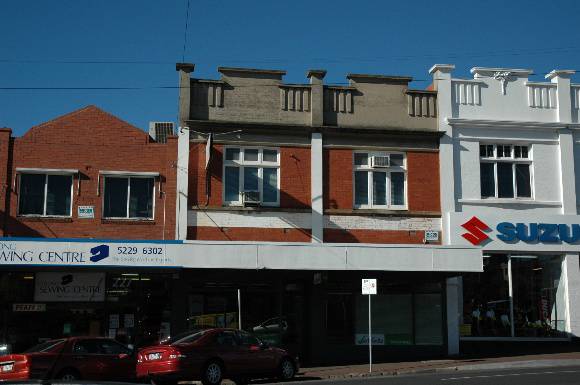| Back to search results » | Back to search page » |
|
Shop & Offices
Other NameSee 229, 229a, 229b, 229-233 Moorabool Street, Geelong Location229 Moorabool Street, GEELONG VIC 3220 - Property No 216452 LevelIncl in HO area indiv sig |
|
Statement of Significance
C Listed - Local Significance Statement of Cultural Significance The shop and offices buildings, 229-233 Moorabool Street, Geelong, have significance as a reasonably intact example of Victorian design (229 Moorabool Street, behind the front facade) and the Federation commercial style. Built in 1865-66 (229 Moorabool St) and 1911-12 (231-233 Moorabool Street), the buildings are a legacy of commercial developments in Geelong between 1865 and 1912. The shop and offices buildings, 229-233 Moorabool Street, are architecturally significant at a LOCAL level. They demonstrates original design qualities of a Victorian (229 Moorabool St only) and a Federation commercial style that were typical for Geelong commercial building developments between c.1908 and 1913. These qualities include the stepped parapets punctuated by square piers and projecting concrete cappings and thin vertical bands, decorative motifs on the parapets, projecting moulded and rendered cornices defining the parapet bases, regular bay compositions separated by rendered (and painted) pilasters, and the unpainted red brick and rendered wall construction (as shown on the northern section fronting Moorabool Street). Other intact or appropriate qualities include the two storey height, two sets of tripartite timber framed casement windows with highlights on the first floor of the northern section fronting Moorabool Street, rendered stringcourse at first floor sill level, painted band underneath the stringcourrse of the northern section, ground floor shopfront openings, ingo and stall boards of the northern section, first floor window openings of the southern (corner) section with timber framed highlights, first timber framed double hung windows on the Myers Street facade, gable roof forms clad in galvanised corrugated iron separated by projecting unpainted brick party walls, and the rear shallow arched window openings accentuated by brick voussoirs. The shop and offices buildings, 229-233 Moorabool Street, are historically significant at a LOCAL level. They are associated with commercial developments in Geelong between 1865 and 1912. In particular, both buildings have associations with the Richardson family. Edith Richardson was the owner of the building at 229 Moorabool Street from 1899 (having been built in 1865-66 for John Masters Barratt, a mathematical instrument maker), while the corner building at 231-233 Moorabool Street was constructed for Edith's husband, Horace Frank Richardson in 1911-12. The front facade and shopfront of the earlier building at 229 Moorabool Street appears to have altered to reflect the design of the neighbouring building in 1911-12. The corner building also has long-standing associations with the motor cycle industry initially with Leonard Pratt from the 1940s and later with Pratt and Osborne Motors. Overall, the shop and offices buildings, 229-233 Moorabool Street, are of LOCAL significance. References Sands & McDougall's Directory of Geelong, 1972, Geelong Historical Records Centre. Sands & McDougall's "Invicta" Geelong Directory, 1968, Geelong Historical Records Centre. Geelong City Council Rate Books (Barwon Ward), 1965-1960, Geelong Historical Records Centre. Town Plan of Geelong 1881, Geelong Historical Records Centre. Morrow, W.J., Index to the Geelong Advertiser 1900-1935, Geelong Historical Records Centre. The Geelong Advertiser, 31 May, 1930. Reports and Drainage Plans, Barwon Water profis system, 1973. Town Plan of Geelong 1881, Geelong Historical Records Centre. Investigator, Journal of the Geelong Historical Society, February 1968, March 1976, and March 1981, Geelong Historical Records Centre.
Group
Retail and Wholesale
Category
Shopping/retail complex




